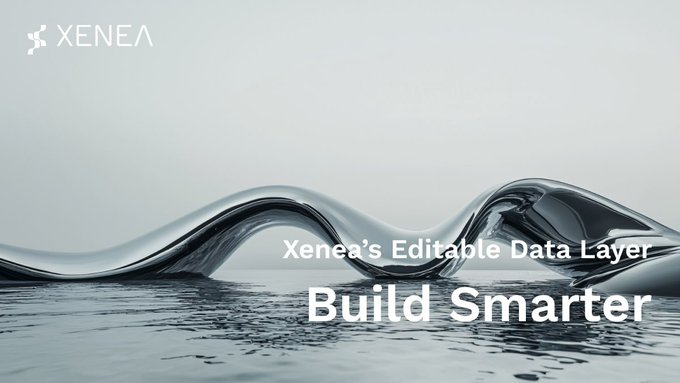Storage Challenges in the Digital Age and the Birth of Xenea
With the explosive growth of digital assets, problems such as data loss and unreliable storage have become increasingly prominent. According to statistics, over 330 million GB of data are generated globally every day, but 90% of NFT metadata face the risk of disappearance due to flawed storage solutions. Meanwhile, the loss of AI training data can lead to the waste of millions of dollars in research. Against this backdrop, Xenea was officially launched in 2025 as the first Layer 1 blockchain that deeply integrates blockchain technology with decentralized storage, aiming to build a “permanent record” infrastructure for digital assets.

Headquartered in Dubai, UAE, Xenea is led by co-founder Tokuro Uhara and backed by a team that centers around academic research. The project’s technical whitepaper has passed peer review by IEEE (Institute of Electrical and Electronics Engineers), a rare achievement in the blockchain space. This scientific rigor has earned the trust of early developers and institutions. For example, in December 2024, Xenea partnered with the Middle East Digital Sovereignty Alliance to explore on-chain storage solutions for government archives.
Technological Innovation: From Dynamic Storage to Keyless Wallets
Decentralized Autonomous Cloud Storage (DACS)
Traditional blockchains (such as Bitcoin and Ethereum) only store transaction records. In contrast, Xenea’s DACS system allows direct on-chain storage of dynamic data (e.g., documents, videos, smart contract states). It leverages a Sustainable Generation Manager (SGM) that automatically shards and replicates data across nodes. Even if some nodes go offline, data can still be recovered through redundant backups. For instance, a user-uploaded PDF will be split into 128 encrypted fragments stored across at least 30 global nodes and can be edited and updated in real time. This design has been integrated with IPFS and is expected to launch a proprietary hash file system in Q4 2025.
Proof of Democracy (PoD) Consensus Mechanism
Unlike traditional consensus models that rely on computing power (PoW) or token staking (PoS), PoD achieves consensus by validating the authenticity of user wallet interactions. Participants must hold a “Mining Passport NFT” to join the process, lowering the entry barrier and avoiding hash power monopolies. Currently, Xenea’s testnet has achieved a transaction speed of 2,300 TPS—1.5 times faster than Solana.
EVM Compatibility and Keyless Wallets
Xenea is fully compatible with the Ethereum Virtual Machine (EVM), allowing developers to seamlessly migrate existing DApps. Its wallet application reconstructs private key management logic through patented secret sharing technology (Patent No. 2019-052099): after logging in via Google or Apple ID, the private key is encrypted and split into three parts, stored across the user’s device, decentralized nodes, and biometric chips (e.g., iPhone’s Secure Enclave). As of April 2025, the Xenea wallet has exceeded 1.2 million downloads across 190 countries.
Token Economy: Balancing Inflation and Ecosystem Incentives
Xenea’s native token, XENE, is not only used for gas fees but also powers the entire storage network’s economy. Its model balances decentralization with sustainability:
-
Supply and Distribution: XENE has a max supply of 1.83 billion tokens, with 65.6% (~1.2 billion) issued at genesis for tech development, ecosystem incentives, and team operations. The remaining 34.4% (~630 million) will be gradually released through PoD mining, with full circulation expected by 2140.
-
Node Incentives: 80% of each transaction fee goes to DACS nodes providing storage, 12% to custodial nodes maintaining network stability, and 8% rewards token holders who participate in governance voting. To curb inflation, block rewards halve every two years, with the first halving scheduled for 2027.
-
Deflationary Mechanism: 30% of all gas fees will be permanently burned. If network utilization exceeds 50%, XENE may enter a deflationary cycle, similar to Ethereum’s post-merge supply reduction in 2023.
Whether XENE will be listed on major exchanges like Binance and JuCoin remains to be seen. Investors may participate via compliant exchanges or stake nodes to earn 6%-9% APY.
Industry Impact and Challenges
Empowering AI and DePIN
Xenea’s storage capabilities are increasingly adopted in the AI and Decentralized Physical Infrastructure Network (DePIN) sectors. For instance, AI firm SynthMind stores training data on Xenea to ensure traceability and immutability. DePIN project Helium uses Xenea to log operational data of global hotspot devices. Such applications may drive a 300% increase in storage demand by 2025.
Regulatory and Performance Bottlenecks
Despite its promising outlook, Xenea faces two major challenges:
-
Data Compliance: The EU’s General Data Protection Regulation (GDPR) prohibits cross-border data transfers, and Xenea’s global node distribution may conflict with this. The team is working with local data centers to launch “regional storage subnets” to address the issue.
-
Dynamic Storage Performance: Real-time editing of large files (e.g., 4K video) may cause 3–5 seconds of synchronization delay. The team plans to scale throughput to 100,000 TPS via sharding technology.
Roadmap and Ecosystem Expansion
Xenea plans to launch payment functionality in Q3 2025, allowing users to make direct purchases via partner merchants using XENE. In addition, its ecosystem fund will allocate $20 million to support storage-intensive applications like decentralized social networks and on-chain publishing. In the long run, Xenea may become the “Digital Noah’s Ark” of the Web3 world, preserving humanity’s most critical data legacy.




